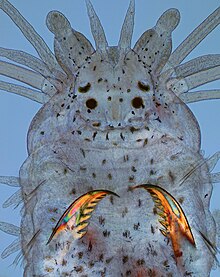Errantia
The division of living beings into systematics is a continuous subject of research. Different systematic classifications exist side by side and one after the other. The taxon treated here has become obsolete due to new research or is not part of the group systematics presented in the German-language Wikipedia.
Errantia (the "stray ligands" [neuter] from latin errare "wander") is the name of a traditional taxon within the annelid class of polychaete (Polychaeta) in which freely movable, so "errante" bristleworms the sessile or halbsessilen Sedentaria placed opposite to and that goes back to Jean Victor Audouin and Henri Milne Edwards . In this description it can be regarded as a synonym of the subclass of the Aciculata , but in more recent times the name has also been used for the upper or lower taxa of the Aciculata.
features

In contrast to the Sedentaria, the Errantia are adapted to rapid and vigorous locomotion, which is why their parapodia have an inner skeleton made of sturdy bristles, the aciculae, to which numerous strong muscles are attached, making the parapodia a means of locomotion. The animals usually have two sensory palps, but no tentacles. Sense organs such as antennae , eyes and nuchal organs are well developed. In addition to substrate eaters , there are numerous scavengers and predators ( carnivores ), who chop up their prey with powerful jaws or grab a muscular evertable pharynx and swallow it whole. Some species such as the fish-eating Eunice aphroditois build living tubes , but can leave them to catch prey.
Errantia as a synonym of the aciculata
Phylogenetic studies since the 1960s on an anatomical and molecular genetic basis have shown that although the Errantia are monophyletic , the Sedentaria must be resolved as a heterogeneous group from a cladistic point of view. Rouse & Fauchald introduced the new name Aciculata in their system in 1998 , in which the previous Errantia are compared to the Canalipalpata , i.e. a part of the previous Sedentaria as a sister group in a new taxon Palpata . The palpata - annelid worms with at least one pair of palps , either sensory palps or palps provided with eyelashes and used for nutrition - are opposed to the scolecida , i.e. annelid worms without antennae and palps, which were previously also counted among the sedentaria. Thus the Errantia, but not the previous Sedentaria, form a natural group according to this system and are therefore obsolete.
Errantia in new classifications
In more recent phylogenetic analyzes on a molecular genetic basis, reference is made to the Errantia either as a superior or as a subordinate clade of the Aciculata .
According to Torsten Hugo Struck and others (2015) as well as Anne Weigert and Christoph Bleidorn (2016), the Errantia comprise the groups Aciculata (with the Phyllodocida and Eunicida ) and Protodriliformia . In the evolution in the sand gap system thereafter played for belonging to the Errantia Protodriliformia particular dwarfing for belonging to the Sedentaria, Orbiniida (with the Orbiniidae ), however Progenese a role.
Cladogram according to Struck et al. 2015 and Weigert & Bleidorn 2016:
| Errantia |
|
|||||||||||||||
|
|
Cladogram according to Parry et al. 2016:
| Aciculata |
|
||||||||||||||||||||||||
|
|
literature
- Stanley J. Edmonds: Fauna of Australia, Volume 4A. Polychaetes & Allies. The Southern Synthesis 4. Commonwealth of Australia, 2000. Class Polychaeta. P. 67, Classification of the Annelida and Polychaeta: Introduction.
- Jean Victor Audouin, Henri Milne Edwards (1832): Classification des Annélides et description de celles qui habitent les côtes de la France. Annales des sciences naturelles, Paris, Sér. 1, 27, pp. 337-447.
- Rodney Phillips Dales (1962): The polychaete stomatodeum and the inter-relationship of the families of the Polychaeta. Proceedings of the Zoological Society of London 139, pp. 389-428.
- Gregory W. Rouse, Kristian Fauchald (1998): Recent views on the status, delineation, and classification of the Annelida. (PDF). American Zoologist. 38 (6), pp. 953-964. doi: 10.1093 / icb / 38.6.953
- Luke A. Parry, Gregory D. Edgecombe, Danny Eibye-Jacobsen, Jakob Vinther (2016): The impact of fossil data on annelid phylogeny inferred from discrete morphological characters. The Royal Society Publishing 2016. DOI: 10.1098 / rspb.2016.1378
- Torsten Hugo Struck, Anja Golombek, Anne Weigert, Franziska Anni Franke, Wilfried Westheide, Günter Purschke, Christoph Bleidorn, Kenneth Michael Halanych (2015): The Evolution of Annelids Reveals Two Adaptive Routes to the Interstitial Realm Current Biology. Current Biology 25 (15), pp. 1993-1999. DOI: 10.1016 / j.cub.2015.06.007
- Anne Weigert, Christoph Bleidorn (2016), Current status of annelid phylogeny. Organisms Diversity and Evolution 16 (2), pp. 345-362. DOI: 10.1007 / s13127-016-0265-7
- Sónia CS Andrade, Marta Novo, Gisele Yukimi Kawauchi, Katrine Worsaae, Fredrik Pleijel, Gonzalo Giribet, Gregory W. Rouse (2015): Articulating “Archiannelids”: Phylogenomics and Annelid Relationships, with Emphasis on Meiofaunal Taxa. Molecular Biology and Evolution 32 (11), pp. 2860-2875.
